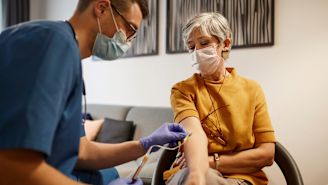Updated on July 14, 2025.
Acute myeloid leukemia (AML) is the most common form of leukemia in adults. This type of cancer begins in the blood and bone marrow (the spongy tissue inside the bones that produces blood cells and platelets which help your blood clot). AML grows quickly, and often requires urgent treatment. People with AML and their caregivers must learn a great deal of information quickly and use that information to make important decisions about treatment. Knowing where to find reliable information can be very helpful.
With that in mind, the below resources offer a good starting point for the kind of background information that can help a person better understand AML. These resources also provide information about other aspects of living with AML—like connecting with peer support and counseling services—and information on stem cell transplants, for those who are treating AML with a stem cell transplant, or who are considering a stem cell transplant. A stem cell transplant is a procedure in which a person receives healthy blood-forming cells to replace ones that are not working or having been destroyed by treatment.
NCI Dictionary of Cancer Terms
AML is complicated. There are many different subtypes, and diagnosis can involve multiple different diagnostic tests to help learn more about how the cancer has mutated—and how it can be treated. Being able to look up a simple definition can be very helpful when you come across unfamiliar cancer terms. Knowing key terms can help you understand what your healthcare providers are discussing or give you a starting point for further reading. Each definition also includes a phonetic spelling and an audio pronunciation, to help you use the term with confidence.
American Cancer Society
The website of the American Cancer Society is one of the best patient education resources for all aspects of treating AML. You’ll find an easy reading guide that covers all the basics of AML—helpful if you or a loved one has just been diagnosed. You’ll find an overview of the different treatment approaches that are commonly used to treat AML (and those that are less commonly used). You’ll also find information on the follow-up care that comes after treatment.
Leukemia & Lymphoma Society
The Leukemia & Lymphoma Society is another great starting point if you are looking for patient education covering different aspects of AML. These resources include discussion guides that cover a variety of different topics and circumstances that may come up during treatment—from choosing a specialist and treatment side effects, to second opinions and addressing a denial of coverage from your health insurance provider.
The Acute Myeloid Leukemia in Adults booklet is also worth downloading—it provides a detailed look at the different aspects of diagnosis and treatment, all written in easy-to-understand language. You can also join the peer-to-peer support program, which matches patients and caregivers with people who’ve had similar experiences with blood cancers. For caregivers, there is a caregiver support page with worksheets to help stay organized while acting as a caregiver.
CancerCare
CancerCare provides a number of free, professional services to people diagnosed with cancer and their loved ones, including access to counseling, resource navigation, information about financial assistance, and online support groups.
Be The Match (BTM)
An allogeneic stem cell transplant in which stem cells come from a donor is a potential treatment option for some people who have AML. Be The Match helps people with blood cancers and other life-threatening illnesses find matching donors. Their site includes information for people with AML who are considering a stem cell transplant, including questions to ask at a first appointment with a transplant doctor.






